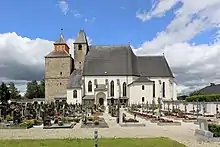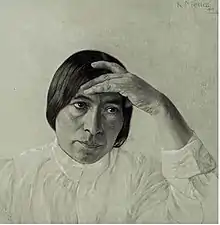Vöcklabruck
![]() Vöcklabruck (German pronunciation: [fœklaˈbʁʊk]) is the administrative center of the Vöcklabruck district, Austria. It is located in the western part of Upper Austria, close to the A1 Autobahn as well as the B1 highway.
Vöcklabruck (German pronunciation: [fœklaˈbʁʊk]) is the administrative center of the Vöcklabruck district, Austria. It is located in the western part of Upper Austria, close to the A1 Autobahn as well as the B1 highway.
Vöcklabruck | |
|---|---|
 | |
 Coat of arms | |
 Vöcklabruck Location within Austria | |
| Coordinates: 48°0′31″N 13°39′21″E | |
| Country | Austria |
| State | Upper Austria |
| District | Vöcklabruck |
| Government | |
| • Mayor | Herbert Walter Brunsteiner (ÖVP) |
| Area | |
| • Total | 15.59 km2 (6.02 sq mi) |
| Elevation | 433 m (1,421 ft) |
| Population (2018-01-01)[2] | |
| • Total | 12,299 |
| • Density | 790/km2 (2,000/sq mi) |
| Time zone | UTC+1 (CET) |
| • Summer (DST) | UTC+2 (CEST) |
| Postal code | 4840 |
| Area code | 07672 |
| Vehicle registration | VB |
| Website | www.voecklabruck.at |
_027-V%C3%B6cklabruck.jpg.webp)
Vöcklabruck's name derives from the River Vöckla which runs through the town, whose name in turn originates from a person's name ('Vechela') and 'Ache', meaning 'flowing water' or 'river'.
Vöcklabruck has many shops as well as services and schools. It was chosen for Europäisches Schützentreffen (the European Meeting of Marksmen) in 2003, and has and will play host to other events such as the Internationale Musiktage (International Music Gathering), Landesgartenschau (provincial garden show) 2007, and an Erdbeerfest (strawberry festival), among others.
Population
| Year | Pop. | ±% |
|---|---|---|
| 1869 | 2,794 | — |
| 1880 | 3,076 | +10.1% |
| 1890 | 3,294 | +7.1% |
| 1900 | 3,562 | +8.1% |
| 1910 | 4,338 | +21.8% |
| 1923 | 4,520 | +4.2% |
| 1934 | 5,017 | +11.0% |
| 1939 | 5,546 | +10.5% |
| 1951 | 8,857 | +59.7% |
| 1961 | 9,353 | +5.6% |
| 1971 | 10,732 | +14.7% |
| 1981 | 11,019 | +2.7% |
| 1991 | 11,239 | +2.0% |
| 2001 | 11,697 | +4.1% |
| 2011 | 11,931 | +2.0% |
Sights

The distance to Salzkammergut's lakes from Vöcklabruck (11 km (7 mi) to the Attersee, 16 km (10 mi) to the Traunsee, 40 km (25 mi) to the Mondsee, 68 km (42 mi) to the Hallstättersee and 72 km (45 mi) to the Wolfgangsee) has led to the town's description as "the gateway to the Salzkammergut". Near the town there are many recreational facilities where people can enjoy both indoor and outdoor activities. Alongside these, Vöcklabruck offers:
- In the town square's tower, frescos discovered in the 1960s. They date from 1502 and were painted by Tyrolean Jörg Kölderer.
- Dörflkirche/Ägidiuskirche' (St. Giles' Church), Baroque church constructed between 1688-1691.
- Schöndorfer Kirche, an early medieval fortified church, built before 824.
- Museum Heimathaus with Wolfsegg Iron
Personalities related to Vöcklabruck

- Leonhard Schiemer (born around 1500-1528), important figure in the Anabaptist movement
- Emilie Mediz-Pelikan (1861-1908), landscape painter
- Oskar Czerwenka (1924–2000), a bass whose residence was expanded to a state music school named after him
- Werner Kreindl (1927-1992), Austrian actor (among other things, student Gerber)
- Gerhard Narholz (born 1937), production music composer/conductor,
- Jim Silye (born 1946), Canadian politician, businessman and former sportsman (football) emigrated to Canada in 1951
- Wolfgang Holzmair (born 1952), renowned baritone recitalist and opera singer
- Franzobel (=Stefan Griebl, born 1967), writer
- David Six (born 1985), musician
- Peter Hackmair (born 1987), Austrian footballer
- Lukas Pöstlberger (born 1992), Austrian cyclist
- Princess Alexandra of Hanover, the daughter of Ernst August, Prince of Hanover and Caroline, Princess of Hanover
International relations
Twin towns — Sister cities
Vöcklabruck is twinned with:
References
- "Dauersiedlungsraum der Gemeinden Politischen Bezirke und Bundesländer - Gebietsstand 1.1.2018". Statistics Austria. Retrieved 10 March 2019.
- "Einwohnerzahl 1.1.2018 nach Gemeinden mit Status, Gebietsstand 1.1.2018". Statistics Austria. Retrieved 9 March 2019.
External links
| Wikimedia Commons has media related to Vöcklabruck. |
| Wikivoyage has a travel guide for Vöcklabruck. |
- Official website (in German)
- Webcam of Vöcklabruck